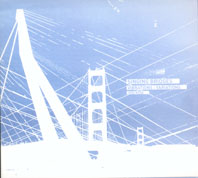: jodi rose & guest artists
Sonicartstar, 2005, 001
www.singingbridges.net
 Singing Bridges, the debut CD from sound artist Jodi Rose, takes the listener on a global journey through the ears of bridges. A double set, the first CD Vibrations is mostly unadorned field recordings. Compiled in chronological order we accompany Rose on her 10 year odyssey starting with her first recording of Sydney’s Anzac Bridge in 1994 (the seed of the obsession), through bridges in Vietnam, Holland, Finland, Germany, UK, USA, Spain, back to Australia and concluding in Finland.
Singing Bridges, the debut CD from sound artist Jodi Rose, takes the listener on a global journey through the ears of bridges. A double set, the first CD Vibrations is mostly unadorned field recordings. Compiled in chronological order we accompany Rose on her 10 year odyssey starting with her first recording of Sydney’s Anzac Bridge in 1994 (the seed of the obsession), through bridges in Vietnam, Holland, Finland, Germany, UK, USA, Spain, back to Australia and concluding in Finland.
While on the surface the sonic palette of most of the bridges offer a booming clanking similarity, several of the recordings stand out as significantly different. The Brooklyn Bridge (track 9) presents sonorities that are deep and ponderous–a worldweary under-rumble with metallic shivers and rolling rattles–concluding with an evocative siren in the distance. In contrast the Golden Gate (track 10) sample is full of fast, high pitched zaps and snaps with a natural flange effect conjuring the sci-fi sonicscape of William Gibson's bridge colonies from Virtual Light and All Tomorrows Parties. The MacIntyre Bridge in Geelong (track 11) has tuned cables that can be played like a crossbred harp and gamelan, and the recording of the Heureka Silta (track 12) bridge in Tikkurila Vantaa Finland provides a minimalist electronic static reminiscent of the finest no-input mixing. The Batman Bridge, Tasmania (track 14) sounds significantly different offering ominous tectonic creaks, low spattered static, and an escalating throaty hum–the bridge is breathing.
Rose's process is mostly one of selection and editing, with little intervention, effects or overlays. The 2 exceptions are the original Anzac Bridge piece mixed on 4-track tape which includes reverb creating an epic grandness, and the F6 Coalmining Bridge in Germany–not a suspension cable bridge like all the others–in which she uses small loops to create a post-human industrial scape. The choice to leave in recording noises and stereo dropouts is sometimes effective and sometimes awkward. However it can be seen in the proliferation of different timbres near the end of the CD that Rose is refining her recording techniques, and developing a more rigorous focus for each event.
It is in CD 2 Variations where all the manipulation takes place. Here the field recordings are remixed (using no additional samples) by artists that Rose has met on her travels. With such rich source material it would be hard not to obsess over the rhythms inherent in the booming structures, consequently many of the pieces are heavily beat-based and would work nicely on the dance floor. Tracks such as Kent McPherson's Matinkaari (track 1), Karl Muller's When Bridges Remix: Traversing the Gap (track 2) and Steve Law's stuttering, dark funk Under a Pylon (track 7) have a pleasing combination of experimentation and head nodding appeal.
Gintas K's Under the Bridge (track 3) is highly looped and rhythmic, but concentrates on the smaller sounds found in the recordings–airy hisses, gurgles and bubbles creating a welcome contrast to the epic-ness of some of the other tracks. Ed Osborne's Footfall 2 (track 9) also steers away from grand gestures choosing to lay small modulating tones over a halting rhythmic bed of taps and creaks creating an interesting gap between processed and raw sounds. In contrast Jonas Oleson takes a glitchy multiply processed approach leaving little sense of the sample in Mekong Delta Blues (track 11). Dariusz Roberte (track 5) more seamlessly remolecularises the source material to create sustained ascending and descending tones forming a choral symphony.
The jewel of Variations, if your stereo can handle it, is Untitled #168 by Francisco Lopez. Beginning with an almost inaudible but physically felt rolling undertone the piece builds adding samples of higher and higher frequency and sharpness to create a panicky experience of being sucked…is it down or up? Dramatically, with a minute to go, the intensity stops, dropping us trembling back to the just audible bass.
In an interview (RT66), Rose states that this is not the end of the bridge obsession, merely the end of a stage. She is currently working on linking live feeds of bridge performances across Finland with the intention of realising her dream, a global bridge symphony. If Singing Bridges is the research stage the final event is going to be something truly special.
Gail Priest






